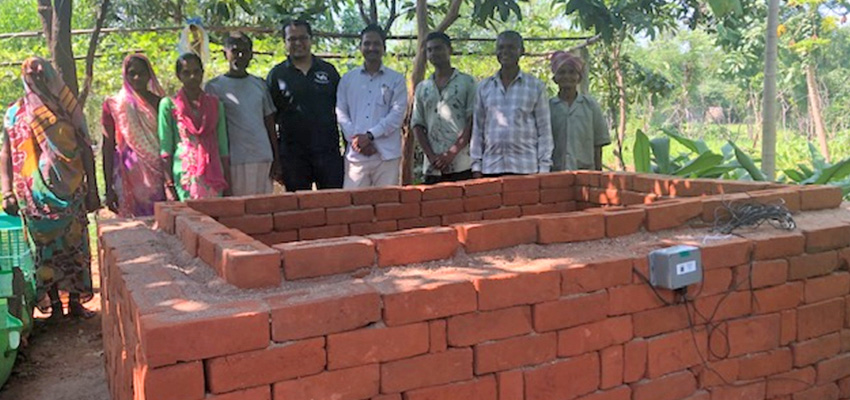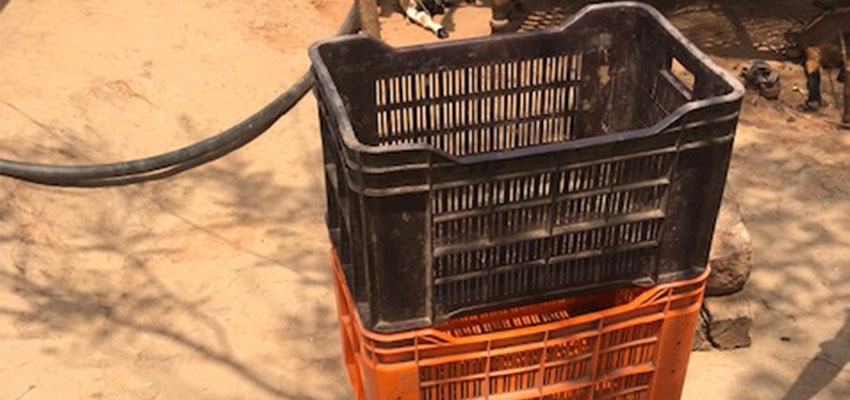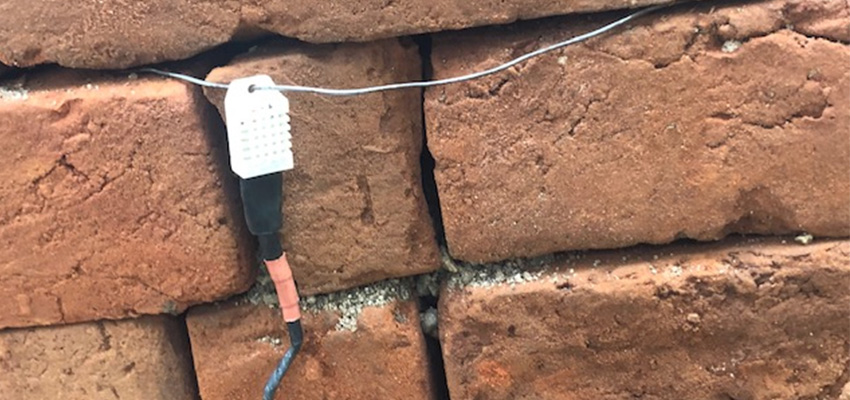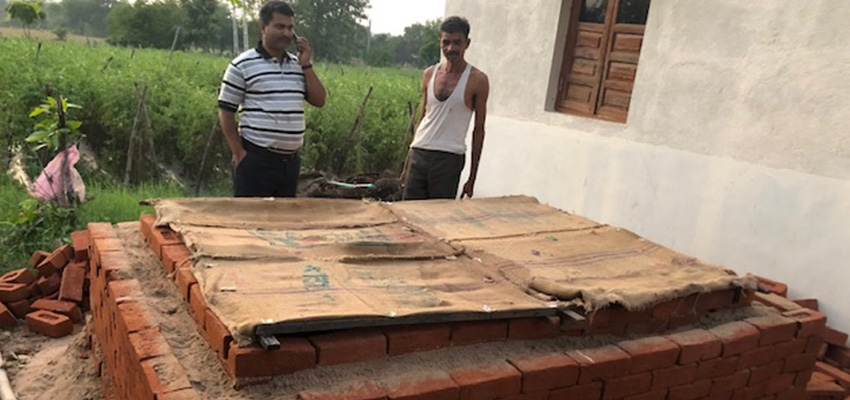
Over the past year as part of my on-going work at D-Lab, I have been working with Collectives for Integrated Livelihood Initiative (CInI - An Initiative of the Tata Trust) to pilot evaporative cooling technologies in Western India. With support from the Abdul Latif Jameel Water and Food Systems Lab (J-WAFS), this work builds upon a scoping study I led in May 2018 which demonstrated the need for evaporative coolers in Gujarat, India to improve vegetable shelf life and farmer incomes. (Read about the initial scoping study here.)
Overview of evaporative cooling technologies
Evaporative cooling technologies function according to a basic principle called “evaporative cooling,” where the evaporation of water from a surface removes heat, creating a cooling effect, in the same way, that the evaporation of perspiration cools the human body. When water evaporates, it takes heat with it, and in relatively low humidity climates like Gujarat, where it is hot and dry during the months of February to June that coincide with the harvest season, technologies that take advantage of this cooling process can effectively preserve vegetables longer and improve their shelf life.

Brick evaporative cooling chambers
Sujit Kumar. and Virendra Vaghani from CInI were instrumental in helping me out during my initial scoping visit and based on the findings from that visit and factoring CInI’s current staff capacity and in consultation with D-Lab Research Engineer Eric Verploegen, we decided to pilot brick evaporative coolers (ECC’s) in the districts of Dahod and Mahisagar of Gujarat. Each ECC we built was capable of storing 400 kg of fruits and vegetables. This size of the device, including the shade cover dimensions were determined considering the dimensions of commonly used storage crates (see figure below), the amount of storage needed by farmers using the chambers, as well as the angle of the sun throughout the year. Please refer to the MIT D-Lab Evaporative Cooling Best Practices Guide (page 11) for detailed step by step instruction to construct and use ECC’s.

Storage crates farmers use to store and transport vegetables.
Work in October 2019
Given CInI’s relationships with local farmers and farmer groups in the region, Mandavav and Goriya village in Dahod and Santrampur village in Mahisagar were selected as the locations to build and pilot the ECC’s. Although the scoping study was conducted in Sabarkantha district as well back in 2018, given CInI’s current staffing capacity and distribution of projects over the next year for their field staff, we decided to skip Sabrankantha district during this visit and focus mainly on Dahod and Mahisagar.
Construction of ECC in Santrampur, Mahisagar
In anticipation of my trip to Gujarat, I had shared a materials list (bricks, sand, bamboo, etc) with CInI so as to have everything procured by my arrival. In this way, we would save time and focus on building the ECC. Kunal Kishore is the current field coordinator for CInI in Santrampur, Mahisagar and helped procure all the materials for the construction of the ECC.
Virendra Vaghani who is stationed in CInI’s head office in Ahmedabad, Gujarat accompanied me to Santrampur where we initially met with Kunal Kishore at CInI’s field office in Santrampur and then left to the field location where a farmer Shankar Bhai agreed to give a portion of his land for the construction of the ECC. Shankar Bhai not only gave us space to build the ECC but was also instrumental in recruiting a few other community members in helping us build the ECC. He promised to be an early adopter of the ECC to test the results of improved vegetable shelf life once the harvest season starts in February 2020.
Virendra, Kunal, Shankar and I, along with a few other CInI Staff and community members Paramvar Manish and Sanjay Bhai, began construction of the first ECC in Santrampur. The ECC consisted of a double wall brick layer with sand filled in between the two brick layers. The thickness of each brick was 7.5 cm and dimensions of the ECC to fit 16 crates of vegetables were inner dimensions of 217 cm * 151 cm * 70 cm. It took us three days to construct the structure of the ECC as shown in the figure above.
I then installed a sensor on this ECC device to measure five readings simultaneously (1) temperature and relative humidity on the inside brick wall surface of the ECC (see figure below), (2) temperature and relative humidity on the outside brick wall surface of the ECC, (3) ambient temperature and relative humidity outside the ECC, (4) temperature of the vegetable stored in a crate and placed inside the ECC and (5) moisture content of the sand. The sensors were designed by Sensen, a company that provides data-driven insights to projects and organizations working in international development.

Construction of ECC in Mandavav and Goriya, Dahod
Having completed the construction of the ECC and sensor installation in Santrampur, Virendra and I traveled to Dahod. Virendra first introduced me to Vivek Vishal who is the CInI field coordinator for Dahod district. The three of us then proceeded to the field location in Mandavav village. Again, this location was selected in consultation with CInI staff keeping in mind their current staffing capacity and connections with farmers in the region. Just as in Santrampur, in Mandavav, Vivek had made sure to procure all the materials before my visit so as to focus on constructing the ECC. He also recruited help from Rameshbhai Kuberbhai Parmar a farmer in Mandavav and a few other community members to construct the ECC. Together, we built the ECC in three days and installed the Sensen sensor similar to the configuration in Santrampur.

In Mandavav, based on feedback from Rameshbhai (who will be the ultimate user of this device) we decided to build a two-level brick step (see figure above) so as to help with access to the vegetables once stored inside the device. Later that week, Vivek and I traveled to Goriya village where we constructed a third ECC device.
Initial results and next steps
CInI has already started testing the units in Santrampur by measuring vegetable shelf life improvements using observational studies. These studies include physical observation for color, the appearance of mold. and shriveling of the vegetables.
Based on initial observations, CInI staff have reported an increase in shelf life from 2-3 days to 6-7 days for vegetables such as eggplant and fenugreek leaves. CInI will continue collecting information from farmer surveys and observation tests during the harvest season from February to May 2020. In June 2020, we will publish a report of the findings from this project, and based on the results of this pilot we will be looking for opportunities to scale the dissemination of evaporative cooling chambers.
More information
Related blog post: Scoping study for Evaporative Coolers in Western India
MIT D-Lab Evaporative Cooling Research
Contact
Anish Paul Antony, MIT D-Lab Postdoctoral Researcher
Eric Verploegen, MIT D-Lab Research Engineer, Evaporative Cooling Lead

